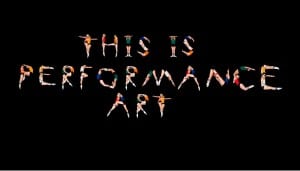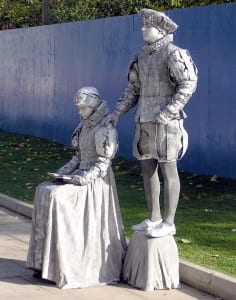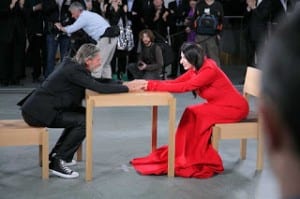Performance Art.
Figure 1: Mel Brimfield, This is Performance Art, 2011, C-print, edition 1.
Many of us could have experienced performance art at some point or another and not even have been aware. Performance art can take place in any location at all. It could involve many people or just one, or sometimes nobody at all. It can be very complicated, or can be something as simple as a person standing on the same spot for a period of time, doing absolutely nothing. The reason I love performance art is because to me it is undefinable and it’s extremely difficult to determine when a performance crosses the line from performance to performance art.
Figure 2: Performance artists in Jubilee Gardens.
Taken by Adrian Pingstone in November 2004.
The above image is another classic example of performance art that we see everywhere and yet have probably never classed as ‘performance art’. Figure one and two both show how a whole performance can be captured and understood in one photo when it comes to performance art. Another thing that interests me is the amount of skill needed to something so little as standing completely motionless for long periods of time like shown in figure two. Drawing from my own experience of when I performed in a commedia dell’arte piece in which we had to stay frozen for over half an hour and were only allowed to move once it got to our turn to act I know how much you need to use your muscles to stay still for such a long time, whilst it make look effortless it takes a lot of work and commitment to pull off, I don’t feel like this is something which is appreciated enough when viewing this kind of work.
One person who I feel has truly mastered Marina Abramovic, my personal favourite of her work being The Artist is Present(2010) A 736-hour and 30-minute piece which spanned over a month and a half where Marina would sit in a chair in the MoMa museum at a table and sit completely motionless while spectators were invited to take turns sitting opposite her.
“Spectators stare on in anticipation but of course Abramovic does nothing. In return, participants cry, scowl and smile. Sometimes all in quick succession. But mostly, they cry. “
-Karimah Ashadu, Art/Design, ‘The Artist is Present’: Marina Abramovic.
Figure 3: A spectator reacting to sitting opposite Abramovic.
One of my favourite moments is when Abramovic’s ex partner and co actor of many years sat opposite her and they were reunited. Even though she stayed motionless throughout the most part of this performance, their hands still reached over the table for each other, it was a very touching moment. The fact that Marina, although almost motionless can provoke such emotion from people as shown above is what I like about this piece of work, it shows that in this case, less is definitely more.
Figure 4: Marina Abramavic and Ulay, reunited.
Works cited:
Figure three and four:
Akers, Matthew (2012) Marina Abramovic: The Artist is Present [DVD] New York.
Accessed online April 2013 at: http://karimahashadu.blogspot.co.uk/2012/07/the-artist-is-present-marina-abramovic.html
Figure one:
Brimfield, Mel (20111) This is Performance Art, First edition, released for Ceri Hand Gallery, London, England
Accessed April 2013 Online at: http://membership.contemporaryartsociety.org/archive/talk-a-short-history-of-performance-art/attachment/belles-4/
Figure two:
Pingstone, Adrian (2004) Performance Artists in Jubilee Gardens, released for public domain, London, England
Accessed April 2013 online at: http://commons.wikimedia.org/wiki/File:Performance.art.london.arp.500pix.jpg



